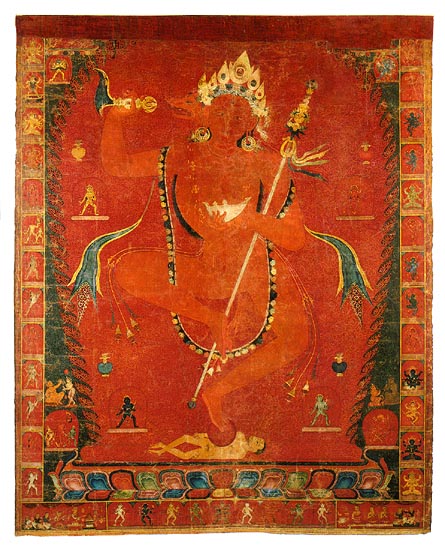<< previous image || Desire & Devotion || next image>>

Vajravarahi with Retinue
Nepal, late 14th century
Pigments on cotton, 42 3/8 x 36 1/8 in (107.6 x 91.8 cm)
Published: Pal 1975B, pp. 62-63 and 82, no. 45
Catalogue #126
|
When this painting was first published (Pal 1975B), I wrote, "although quite damaged, this exceptionally large painting is included here because of its extraordinary quality and its historical importance." The damage is now hardly visible except for the missing register above as the painting has been judiciously and brilliantly restored to reflect its original state. Not only is this one of a very few fourteenth-century painted icons to survive from Nepal, but it is also the largest. The date of the painting can be firmly ascertained by a comparison with the 1367 Vasudhara mandala in another private collection, to which it is closely related (ibid., pp. 58-59, no. 43). The Amazonian central figure in the painting is Vajravarahi, who is
distinguished from other female initiators and embodiments of wisdom
by the sow's head protruding from her head above the right ear. Unlike
Nairatma, however, Vajravarahi is frequently represented by herself
and is an important deity for tantric initiation, especially for new
initiates. For instance, she intercedes far more often in the lives
of the eighty-four mahasiddhas than any other deity. To cite one example,
not only was the great Luipa (eighth-ninth century) initiated into the
mandala of Vajravarahi, but he is supposed to have received direct transmissions
of the Samvaratantra from the goddess, who is characterized as a dakini-a
Sanskrit word that is applied to a female divine initiator (Bowman 1985,
pp. 36-37). In Tibet, Vajravarahi is also the patron deity of the Semding
nunnery. The impressive size of the Ford painting, which represents
a mandala, is likely to have been made for an initiation ceremony of
an important adept. The consecratory scenes depicted in two end panels-separated
lay a group of dancing deities- however, offer no clue to the identification
of the patrons. On the left, a priest known as a Vajracharya offers
oblations (homa) into the fire in the company of an assistant and several
lay persons. On the other side are three monks along with more lay persons,
all of whom seem to be women. Among the ritual implements before the
first monk is a three-dimensional mandala, which is further indicative
of the function of this painted mandala in an initiation ceremony. She is accompanied by the four goddesses Dakini, Lama, Khandaroha, and Rupini within the flaming red aureole of delicate lace-like scrollwork. Each is identical except for her complexion. Beyond, against a similarly rich blue background, beside the two mahasiddhas, are four other goddesses, only two of whom remain intact. They are Vajrayogini, who holds her own severed head with the left hand (and hence also known as Chinnamasta), and a form of Varahi. At the two upper corners are two manifestations of Samvara in yab-yum. Twenty-six goddesses in various poses are included in the two marginal columns. They include, among others, various Dakinis such as Naro Dakini and Buddha Dakini, mother goddesses, Marichi, and others. In the central panel in the bottom register are eight offering goddesses, including Lasya, Mala, and Gita, flanking yet another form of Samvara and Nairatma in yab-yum. Thus, both for its iconographic richness and for introducing a hitherto
unfamiliar mandala of Vajravarahi, this is an important painting for
the history of esoteric Buddhism. It is also an aesthetic tour de force
of the Newari artistic genius, clearly justifying the great esteem in
which Newar artists were held in Tibet and beyond. It is amazing how
effectively the dominating red is used with subtle tonal variations
to create a visual design of compelling force. The powerful goddess
of Amazonian proportions is both physically desirable and spiritually
inspiring. Detail: close-up
#1 all
text and images © The Trustees of the Walters Art Gallery, Baltimore
|
<< previous image || Desire & Devotion || next image>>
